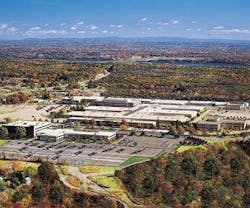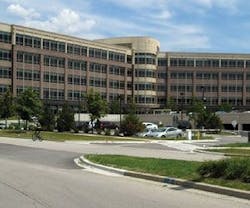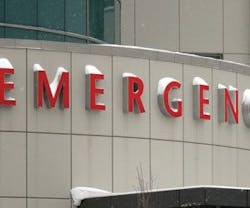Newsworthy
When a 2004 DEC statement reported that, in a typical year of operations, the central power plant at TechCity produced 3,745 pounds of carbon monoxide, 175,748 pounds of sulfur dioxide, 7,464 pounds of other particulates, 41,062 pounds of nitrogen oxides, and 765 pounds of unspecified VOCs – more than 100 tons of pollutants annually – from fossil-fuel consumption, it was clear that something needed to be done.
Alan Ginsberg, the owner and chairman at TechCity in Kingston, NY, discusses the site’s redevelopment and how it achieved its green results.
Buildings: Aside from pollution, what prompted you to shut down the central utility plant and redevelop TechCity?
Ginsberg: The system design, site wide, was antiquated and obsolete. [It] lost energy as it traversed the 260-acre campus, and required 24/7 oversight. Energy costs had begun to skyrocket, [and] we learned that we had to have more control over our property and make each building independent of the common systems. The central utility plant was the perfect starting point for complete redevelopment, improving the air quality, and a continuous, green improvement initiative.
Buildings: Why do you believe that sustainable energy is important for facilities like TechCity?
Ginsberg: As a developer, I want to control my costs and provide the best product to my tenants and community. Homegrown energy is sustainable and clean, and, in the long term, is much less expensive than fossil fuels. Quality of the environment, health of our next generation, and less dependence on oil are all reasons to put a full-court press on renewable energy sources. And, it begins with taking out old, non-efficient systems.
Buildings: What methods were used to help TechCity go green? What features were changed from the former utility plant?
Ginsberg: We wanted to create a mixed-use “eco-village” that was conducive to our community needs. [We replaced the central utility plant] with energy-efficient equipment that provided more financial security and cost reduction. Several large, oil-burning boilers were replaced with smaller, individual, natural gas-fired rooftop units in occupied buildings. This new, energy-efficient system controls the heating and cooling within the buildings that the units serve. Start and stop changes are automatically tied into the time of day.
We are [also] working on approvals to convert approximately 300,000 square feet of existing structure to indoor parking with solar panels on the roof, along with green roofs.
Buildings: What is the overall cost and timeline for the project?
Ginsberg: The initial phase took 18 months and cost approximately $10 million. The overall project cost is estimated at $260 million and will take 5 years [to complete]. The project is ongoing, [and] it will encompass approximately 2.5 million square feet. Each building will be upgraded as office, commercial, retail, light manufacturing, and warehousing. New tenants will have built-out space.
Buildings: What are the benefits of having your facility go green?
Ginsberg: We have already reduced our operational costs and dependence on fossil fuel, [and] we will continue down this path to a development with “net-zero energy” buildings.
Energy costs of approximately $3 million annually were reduced tenfold by the shutdown of the old plant, more than 100 tons of pollutant emissions were halted in the conversion to individual gas-fired rooftop units, a 36-percent reduction [in electricity usage] was made possible by energy efficiencies, and 974 tons of CO2 were eliminated.
HSBC North American HQ is Green Development of the Year
The HSBC North American Headquarters building in Mettawa, IL, has been named Green Development of the Year by the Commercial Real Estate Development Association (NAIOP). The building has a LEED® Gold certification.
HSBC used the U.S. Green Building Council’s LEED rating system to apply sustainable principles to a 550,000-square-foot office complex, which includes six floors of office space, a fitness center, a full-service kitchen and dining facility, banking services, a mission-critical data center, and a career-development center with training facilities. Other features include low-flow fixtures, dual-flush toilets, and a 30,000-gallon rainwater reuse system that reduces wastewater generation by 82 percent and water usage by 68 percent.
The site also uses an energy-efficient envelope and MEP systems design to save 45.1 percent in energy costs over the ASHRAE 90.1-1999 energy standard, as well as an underfloor air distribution system, carbon-dioxide monitoring, and a complete daylighting control system with automated window blinds and solar tracking system.
HSBC encourages employees to use alternative public transportation and fuel-efficient automobiles by providing shuttle service to metro lines, priority parking for approved efficient cars, and bicycle storage and changing rooms, in addition to green education and outreach to employees and the community.
Legislation Contains Financial Incentives for Green Roof Installation
Recently, Washington State Senator Maria Cantwell introduced the Clean Energy Stimulus and Investment Assurance Act of 2009 (S 320) to the Senate. The bill aims to provide financial incentives for commercial green roof installation.
If approved, the bill, drafted in part by Green Roofs for Healthy Cities, a non-profit industry association, along with the American Society of Landscape Architects, will provide a 30-percent tax credit for qualified green roof expenditures for new and retrofit projects, as long as at least 50 percent of the roof area is covered with a green roof. The bill will also create a large number of green-collar jobs for manufacturers, nurseries, designers, and installation and maintenance professionals, as well as help save energy, improve stormwater management, cool cities, cleanse the air, and beautify rooftops.
Brookhaven College Breaks Ground on Sustainable Building
Ground for the new, 28,500-square-foot Workforce and Continuing Education Building at Brookhaven College in Farmers Branch, TX, has been broken. Scheduled to open in January 2010, the building, which is part of the Dallas County Community College District, was designed to be a sustainable, flexible, multi-purpose building to house corporate and continuing-education programs, general classrooms, and support space.
The building will include 15 new classrooms, all of which will have laptop carts, as well as a separate computer/information technology lab, four multi-purpose rooms, two conference rooms, a lobby area, break stations, departmental offices, and outdoor patios and gardens. Additionally, the building will incorporate many sustainable and environmentally friendly features, such as a polished concrete floor, low-VOC paints, and sealants that will not release VOCs into the building to improve indoor air quality; north-facing glass to allow ample indirect natural light into the building; and a highly reflective roof to minimize heat gain. The project team also improved existing site drainage and used a grass pave system for the required fire lane to reduce runoff and visually improve the north court of the building.
Recession Changes the Reasons for Purchasing Green Products
A recent survey by The Shelton Group showed that, while consumers are still willing to buy energy-efficient products and services in the shaky economy, the recession has caused a significant change in their reasons for doing so.
According to the survey, 71 percent of consumers cited saving money as their top reason for buying energy-efficient products, while 55 percent cited “to protect the environment,” and 49 percent cited “to protect the quality of life for future generations.” These results are greatly different than the results of similar surveys conducted by The Shelton Group in 2006 and 2007 before the recession, in which consumers cited “to protect the environment” as their reason for buying energy-efficient products most often.
NYC is Highest-Priced Office Market Worldwide
Premium office space in Midtown Manhattan peaked at $225 per square foot in 2008, before the downward economy took its toll, making it, once again, the highest-priced office market in the world, according to NAI Global’s 2009 Global Market Report. Drops in rent prices in other world markets, such as London’s Mayfair region and Hong Kong, allowed Midtown Manhattan to reclaim its title.
New York’s Midtown Manhattan peak rents are still more than double the highest rents reported in any other market in the United States for downtown Class-A space, with San Francisco’s downtown region being second highest in the United States, with peak rents at $110 per square foot, followed by New York City’s Downtown Manhattan and Boston’s Financial District being the third highest at $65 per square foot.
Hospitals Feel Economic Downturn
Hospitals are facing tough times ahead as the nation’s economic troubles force a decrease in hospital services used. A report based on a survey of 736 hospitals, and information from DATABANK, a Web-based reporting system used in 30 states to track key hospital trends, showed that fewer patients are seeking hospital care, while there’s an increase in patients who need help to pay for their care.
The report also shows that faltering financial health and ability to borrow funds for improving facilities and updating technology, as well as worries about potential cuts to Medicare and Medicaid, are forcing hospitals to make (or consider making) cutbacks, including cutting administrative costs, reducing staff, and reducing services. Because government payors do not cover the costs of care, hospitals often rely on investment income to help make ends meet; the current economic situation has had a further worsening effect on hospitals’ financial conditions.
The increased cost of borrowing money is also making it difficult for hospitals to find financing for facility and technology improvements. According to the survey, 56 percent of respondents might hold off on renovations or plans to increase capacity, 45 percent of respondents are delaying purchase of clinical technology or equipment, and 39 percent are putting off investments in new information technology.



